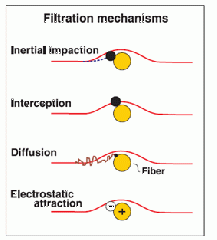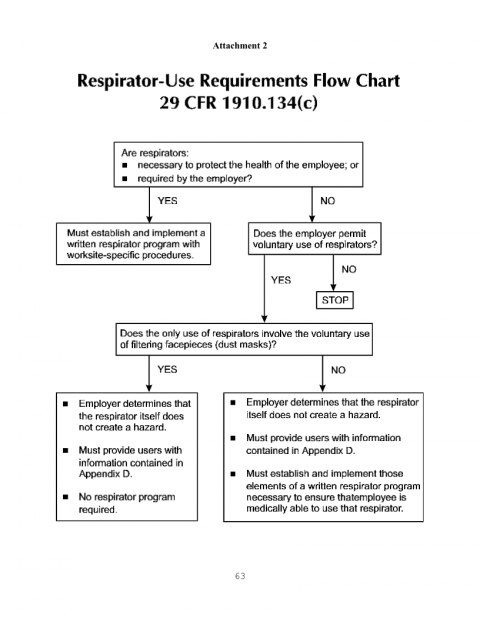Respiratory Protection
The Respiratory Protection Standard (29 CFR 1910.134) makes for certain requirements depending on whether respirators are required by the employer and the types of respirators being used. The flowchart included at the bottom of this article is a quick way to determine these requirements.
What Is a Respirator?
Respirators include SCBA, supplied air — including even the simple filtering facepiece (dust mask)
How do filters collect particles?
These capture — or filtration — mechanisms are described as follows:
Inertial impaction: With this mechanism, particles having too much inertia due to size or mass cannot follow the airstream as it is diverted around a filter fiber. This mechanism is responsible for collecting larger particles.
Interception: As particles pass close to a filter fiber, they may be intercepted by the fiber. Again, this mechanism is responsible for collecting larger particles.
Diffusion: Small particles are constantly bombarded by air molecules, which causes them to deviate from the airstream and come into contact with a filter fiber. This mechanism is responsible for collecting smaller particles.
Electrostatic attraction: Oppositely charged particles are attracted to a charged fiber. This collection mechanism does not favor a certain particle size.
Classification of Respirators
There are two ways to provide clean air to the individual wearing the respirator:
- Purify the air surrounding the employee;
- Supply clean air from an outside source.
Air-Purifying Respirators
There are three methods of purifying, or filtering, the air:
- Particulate — Filtering particles from the air based on size.
- Gas/Vapor — Absorption/adsorption of a toxic substance that is too small to be caught by particulate filters.
- Combination — This is simply a combination of the two methods above. Usually, one type of cartridge is stacked in series with the other type of cartridge.
Atmosphere-Supplying Respirators
There are also three ways to supply pre-cleaned air to the wearer:
- Air-Supplied / Supplied-Air / Atmosphere-Supplying Respirators
- Self-Contained Breathing Apparatus (SCBA)
- Combination Respirators
Physical/Dimensional Characteristics
In addition to classifying respirators by the method of providing clean air to the employee, respirators can be classified by the physical/dimensional characteristics of the respirator itself.
- Disposable vs. Reusable
- Facepiece: "Half Mask" vs. "Full" vs. "Quarter"
- The quarter is rarely used.
- Powered
- Supplied-Air
Source: OSHA's Small Entity Compliance Guide for the Respiratory Standard[1]
Breathing Zone
The Breathing Zone of an employee is an area around the employee's mouth and nose that is small enough to accurately represent the air breathed by the employee. Therefore, the zone should be as small as feasible to allow placement of air monitoring media so that representative air is pulled without actually being over the mouth and/or nose of the employee.
According to a February 3, 1999 letter of interpretation by OSHA titled "Correct placement of air sampling cassettes on employees performing welding operations,"[2] the Breathing Zone should be a hemisphere with a radius of no greater than nine inches (9"), where the radius origin sits between the mouth and nose and the hemisphere is forward of the shoulders.
The correct placement for air sampling cassettes is near the breathing zone of the employee. It should be as close as possible to the nose and mouth of the employee, i.e., in a hemisphere forward of the shoulders with a radius of 6 to 9 inches. If the employee is wearing a welding helmet and either no respirator or a negative pressure respirator, sampling should be done inside the helmet.[2]
Respirable Particle
- Respirable particles are those particles in the size range which would be deposited in the gas exchange region of the lung. Particles too large to be inhaled are collected in a grit pot on the cyclone. The respirable fraction is captured on a pre-weighed PVC filter for gravimetric analysis.
- Respirable dust sampling uses a cyclone to separate and capture the particles within that size range.
- At KYOSH, a Dorr-Oliver cyclone is used in an MSA sampling train.
- Appendix B to OTM Section II: Chapter 1 lists dusts for which respirable sampling should be performed.
Assigned Protection Factors (APF)
The following table lists the APF of the different types of respirators.
The APF is a factor that is used to determine the maximum airborne levels of a toxin that a certain type of respirator can protect against. For example, if the PEL of a certain toxin is 10 mg/m³ and the type of respirator provides an APF of 10, then the maximum levels of that toxin that an employee can use that respirator safely is 100 mg/m³.
Terminology Not Covered Elsewhere
- Adsorption is the adhesion of atoms, ions, or molecules from a gas, liquid, or dissolved solid to a surface. This process creates a film of the adsorbate on the surface of the adsorbent. This process differs from absorption, in which a fluid (the absorbate) permeates or is dissolved by a liquid or solid (the absorbent). Adsorption is a surface-based phenomenon while absorption involves the whole volume of the material. The term sorption encompasses both processes, while desorption is the reverse of it.[3]
Oil-Tolerance Letter Designation for Particulate Filters
The following information was pulled from the publication titled, "NIOSH Respirator Selection Logic."[4]
9.2. A filter series (N, R or P) that will provide protection against exposure to the particulate in question is recommended.
a. The selection of N-, R-, and P-series filters depends on the presence or absence of oil particles, as follows:
- If no oil particles are present in the work environment, use a filter of any series (i.e., N-, R-, or P-series).
- If oil particles (e.g., lubricants, cutting fluids, glycerine, etc.) are present, use an R- or P-series filter. Note: N-series filters cannot be used if oil particles are present.
- If oil particles are present and the filter is to be used for more than one work shift, use only a P-series filter.
Note: To help you remember the filter series, use the following guide:
- N for Not resistant to oil,
- R for Resistant to oil,
- P for oil Proof
b. Selection of filter efficiency (i.e., 95%, 99%, or 99.97%) depends on how much filter leakage can be accepted. Higher filter efficiency means lower filter leakage.
Additional information on selecting the appropriate filter certified under 42CFR84 can be found at http://www.cdc.gov/NIOSH/userguid.html.


